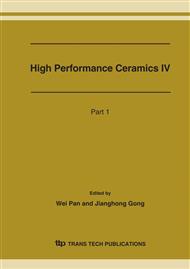p.2228
p.2232
p.2235
p.2238
p.2242
p.2247
p.2251
p.2254
p.2257
Nanocomposites – Toughened Ceramics
Abstract:
In order to improve fracture toughness of ceramics, an intrinsically small frontal process zone (FPZ) size must be expanded. An intra-type nano-structure, where nano-particles are embedded within matrix grains, yields dislocations around the dispersed particles due to residual stresses. These dislocations become sessile dislocations at room temperature, operate as origins of small stress concentration in the matrix, and create nano-cracks in the FPZ. To produce the intra-type nano-structure, we developed a soaking method. This method makes it possible to produce nano-sized metallic particles dispersed within ceramic powders. In this research, alumina-nickel nanocomposite powder was obtained using the soaking method. The powder mixed with α-alumina as a seed was sintered using a pulse electric current sintering technique. The sintered nanocomposites are then annealed to disperse dislocations around the nanoparticles into alumina grains. Results showed that the maximum fracture toughness was 7.6 MPam1/2, which was two times higher than that of alumina.
Info:
Periodical:
Pages:
2242-2246
Citation:
Online since:
April 2007
Authors:
Price:
Сopyright:
© 2007 Trans Tech Publications Ltd. All Rights Reserved
Share:
Citation:


